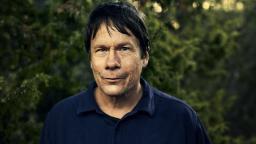
Spindelbjörken
(The Spider Birch)
by Pär Hansson
reviewed by Eva Corijn
The Spider Birch begins and ends with adult writer Joel revisiting his childhood home in Västerbotten, along with his wife and two children. In between, the story switches to Joel’s childhood in the late seventies. Written in the third person, this part makes up most of the story and masterfully captures the world through Joel’s eyes as he comes of age. There are the typical trappings of childhood: a beloved metallic turquoise bike, a broken arm, visits to grandma, days spent fishing. Reality blends into dreams: the family’s sheep give sage advice when Joel whispers his secrets to them, and from time to time, Joel likes to take flight and soar over town.
There is a deeper core of darkness, though: bullying described with a wide-eyed matter-of-factness that makes it all the more painful. Slightly effeminate Joel is shouted at, beaten up as his classmates watch on, even forced to drink piss while his abusers laugh. Two heartbreaking lines capture how this scars him for life: ‘From then on, he sometimes struggled to understand why people laughed. Struggled to see their laughter as anything other than a way to display power or blend in.’ As an adult, Joel struggles with outbursts of anger, sullen silence, and a strange forgetfulness
Joel’s friend Kim plays an elusive role in the former’s life. Charming yet manipulative, a constant presence yet never there when Joel really needs him, he is difficult to pin down. Is he as lonely as Joel, or does he just want an audience? How consensual is the sexual exploration the two engage in? Precisely because of this, Kim is one of the most interesting characters in the book.
Meanwhile, the other characters in the book never quite sharpen into anything more than outlines. The girls Joel plays with as a child. His parents. His friend Isak – a dull and devout Christian, a safe choice. Even Joel’s brother Palle, ‘who might just be his best friend’, and his wife Karin. It is as if adult Joel is trapped in the voicelessness of the child he used to be: whenever he tries to connect with those closest to him, he fails to bridge the loneliness and hurt he so desperately wants to escape:
I am out kayaking on Harpsundssjön lake and for a second, I feel strong and free. Life turned out alright in the end. I did really well, I say to myself encouragingly. I have Karin and the children. I have friends and acquaintances who know me. [...] I am in charge of my own life in spite of everything. Maybe not always happy, but [I never saw] happiness as a goal in and of itself.
Stylistically, Hansson weaves words as cleverly as a fish flitting through the Ume River. The book is written in short snapshots rather than full chapters. Minimalist at first sight, Hansson’s sentences contain bursts of descriptive brilliance: ‘Holding a live grayling in your hands. Pure muscle with silvery scales and a petrol-blue dorsal fin, plucked from its world of sand, shimmering water and the shiver of dragonflies.’
Hansson also manages to maintain a constant sense of dread, as if something is looming in the shadows of the ‘spider birch’ tree outside Joel’s childhood home. As the tree’s branches scrape against the bedroom window, neither we nor Joel ever feel quite safe. Who is this anonymous presence visiting Joel in the midnight hours – a spectre he’s dreamt up, or an actual person standing by his bedside? Will the evil twins that roam the streets ever catch up with Joel as he tries to outrun them?
At times, the vagueness of the story is frustrating, even a tad boring. I briefly wondered whether a revisited childhood might be more interesting to the author than the actual readers. And turning the final pages, I couldn’t help but feel that the built-up dread didn’t quite lead anywhere.
But this is not a novel you read for its plot. It is one you read to lose yourself in the syllables and scents of the forests up north, of hours spent kayaking in the cold, of growing up in a small köping with nothing much to do and nowhere to go. A novel you read for the experience rather than its explanations. More than anything, it is a compelling invitation to wonder whether our childhood is something we lost, or something we managed to leave behind.

Spindelbjörken
Norstedts, 2023
290 pages
Foreign rights: Lina Sjögren, Norstedts
Pär Hansson is a poet, author and translator. He made his debut in 1998 with the poetry collection Ruckel (‘Hovel’). In 2013 he was awarded the Norrland Literature Prize for Vi plockar bär i civilisationen (‘We pick berries in civilization’), and in 2016 his collection Kajak (‘Kayak’) was nominated for Sveriges Radio's Poetry Prize. Spindelbjörken is his first novel.
